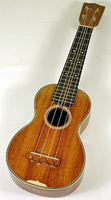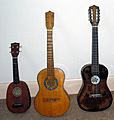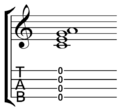Ukulele facts for kids
 |
|
| String instrument | |
|---|---|
| Classification | String instrument (plucked, nylon stringed instrument usually played with the bare thumb and/or fingertips, or a felt pick.) |
| Related instruments | |
|
|
The ukulele (say it: yoo-kuh-LAY-lee) is a cool musical instrument with four strings. People often call it the uke for short. Ukuleles are part of the guitar family, but they are much smaller!
Most ukuleles have nylon strings. The strings are usually tuned to notes like G, C, E, and A. Sometimes, they are tuned to A, D, F#, and B.
Ukulele Sizes
Ukuleles come in different sizes, which changes their sound and how they feel to play. The four most common sizes are:
- Soprano
- Concert
- Tenor
- Baritone
There are also super tiny sopranino ukuleles and bigger bass ukuleles.
Most ukuleles use the standard tuning (G, C, E, A). But baritone ukuleles are special! They are tuned to D, G, B, and E. These are the same notes as the top four strings of a guitar. Bass ukuleles are even bigger and are tuned like a bass guitar or a double bass (E, A, D, G).
Where Did Ukuleles Come From?
The ukulele was first made in the 1800s in Hawaii. People there got the idea from small, guitar-like instruments. These instruments were called cavaquinhos. Sailors from Portugal brought them to the island. The Hawaiian people loved them and created their own version, which became the ukulele we know today!
Images for kids
-
A boy in Hawaii holding a ukulele.
See also
 In Spanish: Ukelele para niños
In Spanish: Ukelele para niños







